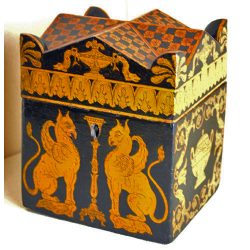Tea Caddies of the 18th and 19th Century
Tea, Status and Storage Part Two – Tea Caddies of the Late 18th and Early 19th Century
This blog continues to explore tea and the development of tea caddy design from the late 18th through the 19th century. By the early 18th century, tea had become an important part of English social life. So it is not surprisng that by the last half of the 18th century important designers were including boxes for tea storage in their design books. Both Thomas Chippendale and George Hepplewhite had a page devoted to tea chest design; Hepplewhite also had a page of tea caddy designs. (As you will remember from my previous blog, tea chests had removable containers for tea, tea caddies were containers in their own right. By the 19th century the terminology had changed so that tea caddy described both type of boxes.) Throughout the 19th century tea caddy design evolved to reflect the changing tastes and attitudes of the era.
The difference between the 1762 designs of Chippendale’s The Gentleman & Cabinet-Maker’s Director (see my earlier blog) and the 1788 designs from Hepplewhite’s Cabinet Maker and Upholsterer’s Guide parallel the trends in style. The shapes of the tea chests were generally similar, but Hepplewhite  replaced metal mounts with neoclassical inlays. His tea caddies boasted more varied shapes and sizes.
replaced metal mounts with neoclassical inlays. His tea caddies boasted more varied shapes and sizes.
There were single, double and triple sizes. The tea chests were double or triple
sized. The double size had two compartments for two different types of tea; or one tea compartment and one recessed area which contained a glass bowl for sugar storage. The triple size usually had two compartments for tea and one for a sugar bowl, though occasionally there were three tea compartments, presumably because the owners were protesting the use of slaves in the production of sugar and were thus boycotting sugar.
The Hepplewhite style was marked by having no feet, being of square, oval, oblong, polygonal or elliptical shape. The tea caddies have straight sides, generally flat lids, though occasionally domed or concave lids are utilized. In tortoiseshell or ivory caddies the tops are sometime pyramidal. Sometimes you will find a small handle or finial on the top; keyholes are inlaid with ivory, bone or boxwood. They are enhanced by inlays of contrasting woods and sometimes embellished with engraved lines. Often the boxwood inlays are shaded by use of controlled burning in hot sand. (more…)
